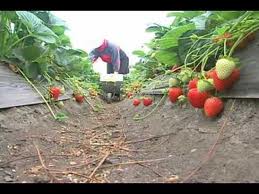Strawberry Planting Time -Wally Richards
Garden Centres in most areas now have the new seasons strawberry plants available for gardeners. You may find a range of types but likely the most common variety found these days is Pajaro.
The NZ Berry Growers web site has this to say about Pajaro; Type: Short day, General description: UC variety. Consistently very large. Bright red skin, light red flesh. Exceptionally firm. Excellent flavour when picked fully ripe but can be insipid when picked under-ripe. Average yields, but exceptional quality results in high export grade out.

Pajaro cropping
It is interesting to note that about 80% of the commercial strawberries grown are Pajaro. Pajaro is only one variety that I have planted along with Baby Pink, Temptation, Sundae and Supreme. These are fairly new types and good value to have a few plants of each type.
I also have the original alpine (white strawberries) which I find are delicious when fully ripe even though the berries are a bit small. The alpine produce just about all year long and the Pajaro crops about November with pickings through to about March: if the weather is not too hot, and another flush in late summer early autumn.
South Island readers are likely to have Aptos which are; Day neutral, General description: UC variety. Bright, dark red. Goes very dark as it becomes over-ripe. Size medium – large. Plants shows Potassium deficiency symptoms, especially late season, showing up as purple margins on leaves. Large fruit number per truss with last fruit tending to be very small. Flavour good but can be slightly astringent in some conditions. Slightly soft. Excellent yield.
Cultural notes: Ensure good plant size before allowing flowers to form fruit to minimise small size tendency. Maintain good potassium levels late in the season. (Fruit and Flower Power) Difficult to produce quality fruit on second year plants. Sensitive to mite attack.
You are also likely to find older varieties such as Red Gauntlet and Tioga.
The Alpine strawberries are likely to be found in with herb displays. You only need one or two plants to start with as they self seed easily and pop up all over. A nice ornamental plant also for under trees and shrubs.
One of the problems with buying strawberries from your green grocer is that commercial strawberries are often grown with excessive nitrogen which means if you place them in the fridge they go mushy in a few days. Home grown strawberries, grown correctly, do not go mushy they dehydrate in a fridge. (Interesting bit I learnt recently). You can either grow strawberry plants in the garden or in containers especially longer troughs about 16cm deep. In the soil you can work in animal manure based compost, mixed half and half with untreated sawdust. (Native timber is preferred but pine will do. Strawberries are a woodland plant and you are providing the right micro-organisms with the sawdust mix.) For containers use the above compost and sawdust mix with a little top soil added. (about 10%) The sooner you get your new plants in the better. I find that first year plants produce reasonably if in early (about now) where they perform better the second year onwards to about years 4 to 5. They need then to be divided and fresher plants re-planted. I like to place a few sheep manure pellets and some Gypsum in each planting hole. Water in with a mix of Mycorrcin and MBL (Magic Botanic Liquid) Mycorrcin which is an organic feed for soil life can make a big difference to your crop size as trials have shown a 200 to 400% increase in berries and size of berries. Then a 2 to 4 weekly spray of the two products will ensure greater returns and healthy plants. By using these products I am able to keep plants producing well for about 4 years. Side dressings of Fruit and Flower Power and either sheep manure pellets or Bio Boost gives the extra food for replacing the original compost goodness. Each winter place fresh saw dust around the plants. If mites or aphids attack the plants spray with Neem Tree Oil on both sides of the foliage, late in the day after the sun has gone off the plants. (Alternative is Liquid Sulphur)
If conditions are damp and botrytis is noticed spray the plants once a month with Perkfection.
Using the above methods from a 3 metre trough (see below) we crop sufficient berries for eating and the surplus, every few days, are frozen for making real strawberry jam.
My favourite method of growing is in a widow box type trough on the top rail of an iron fence. If its a location which gets a reasonable amount of sun the plants will do well. I find that the plants tend to cascade over the open side of the trough with many of the strawberries growing over the edge. This makes it difficult for birds to get the hanging berries. To solve the bird problems a length of Bird Repeller Ribbon suspended between two low stakes, the length of the row, keeps most damage to a minimum. Place the ribbon when the first berries are ripening and remove once the crop has finished for the season.
The main points to remember are the use of sawdust or fine bark chips, regular sprays of Mycorrcin. Use no chemical fertilisers or sprays as these harm the natural healthy environment you are trying to maintain. Your feeding should only be natural products that will ensure healthy plants and great berries!
For a description of common strawberry varieties go here:
http://www.hortnet.co.nz/publications/hortfacts/bvd/bvd/bvd1.htm (Tim)

